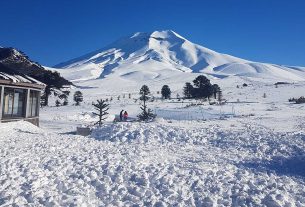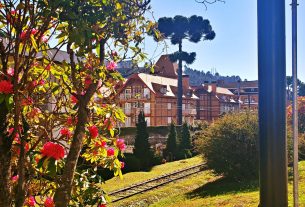When it comes to the sea, the first destination for most miners can only be one: Guarapari. With around three dozen beaches and just over 100 thousand inhabitants, the largest resort in Espírito Santo is part of the childhood memories of many Belo Horizonte residents. Eat churros at Praia das Castanheiras, catch waves at Praia do Morro and make sculptures and castles with black sand. The various attractions for kids make Guarapari a very family-friendly travel itinerary and leave the city crowded with children and teenagers.
But, despite the fact that most miners have one foot or another stuck in those waters, today there is a stupid prejudice against this ancient indigenous village in Espírito Santo. At least in Minas Gerais. I’ve seen people frown when I told them I was going to spend my holidays in Guarapari. The state is well known for the Serra do Espírito Santo, another destination acclaimed by tourists.
Embracing our Minas Gerais soul and ready to show what’s good about Guarapari, we started the first backpacking trip of our lives there, at the end of 2009. As the day dawned, we disembarked in the so-called “Cidade Saúde” and headed straight to the beaches from the center. They are very close to each other, which allows you to see several at once. During 8 days, we also visited Meaípe, Enseada Azul and, of course, the much talked about – whether good or bad – Praia do Morro. We also included a schooner ride, which at the time cost R$20, to visit other beaches in the region.
See too: Where to stay in Guarapari
You know that story about the village that suddenly grew, growing until it was swamped with buildings? This is the case of Guarapari. The village emerged more than three hundred years ago, following in the footsteps of Father Anchieta. So get ready to walk through alleys and hills surrounded by buildings taller than ten floors.
Tourism has brought a good structure to the city. There are a reasonable number of supermarkets, bakeries and restaurants. But as Guarapari receives up to 700,000 tourists in the summer, it can be a bit complicated to shop at this time of year. You need to be patient and be ready to face queues. Furthermore, the bars are crowded and at night there may be a waiting list. The muvuca also slows down traffic. While we stayed there, it was difficult to buy water, milk and the worst – even beer. Now, out of season things are much calmer and you can feel that the city is yours alone, with cheaper beach houses in guarapari for rent.
Guarapari has other alternatives besides beach, lunch and more beach programming. The city has a permanent aquarium and several diving courses. At night, the bars and restaurants in the center and Praia do Morro are crowded. Meaípe is home to nightclubs, including one of the biggest concert venues in Latin America, Multiplace Mais. During the summer and carnival, the city hall usually schedules free shows at Praia do Morro.
Castanheiras Beach

Amidst the rocks and corals and next to Clube Siribeira, Praia das Castanheiras is part of one of the most beautiful views in the city. The calm sea, with almost no waves, makes it a family place. Children everywhere, mothers breastfeeding babies and lots of boys lost in the sand. If you have children, it is a good alternative. If you prefer to avoid the crowds, it’s best to choose another beach, at least during the summer.
Areia Preta Beach
If while walking along the boardwalk you come across a bunch of ladies buried up to their necks in the sand, don’t be alarmed. You have arrived at Praia da Areia Preta. She is largely responsible for Guarapari’s fame. Rumor has it that black sand is good for your health. There are people who claim to have cured themselves of everything just by burying themselves in the sand, from ringworm to rheumatism and even cancer.
But, let’s take it easy! Before you get bogged down in sand, it’s worth remembering that none of this has scientific proof. Other than that, the beach is actually nice and has a little more waves than Castanheiras, right next door. But nothing that will scare kids or make your surfboard useful. During the afternoon there is a younger crowd and the beach becomes a little more lively, with games in the sand and many couples bathing in the sea. Tip: it’s a good idea to take something to protect you from the sun, as there are no shade trees there.
Morro Beach, the most popular in Guarapari
There are four kilometers of beach and dozens of kiosks. This is where the biggest action in the city takes place. But this is also where the best-known farofa in the region takes place. In summer, the beach is crowded and it can be difficult to find a place to put an umbrella. When the city is not so crowded, it is a great alternative. In high season, to avoid those swimmers carrying a cooler full of chicken, farofa and beer, you can walk to the end of the boardwalk. There you will find Morro da Pescaria, the one that gives the beach its name.

Currently the place is an environmental reserve and has well-indicated trails, which allow walking through the native forest. At the end of the route, a prize: behind the trails is Praia do Ermitão, which is usually deserted. In low season, some say that on this beach there are people who enter the sea the way they came into the world. But for those who are more excited, it’s worth warning: the place is not recognized as a naturist beach.
On the opposite side of Morro da Pescaria (and also at the end of the promenade), there is Praia da Cerca, which is very beautiful and has a nice structure, with kiosks selling typical foods from the region, such as portions of fish and the famous Moqueca Espírito Santo . One advantage is that this beach is not as crowded as Praia do Morro, even during the summer.
Blue Cove
Without a doubt, the most beautiful set of beaches in Guarapari. Guaibura, Peracanga and the most famous: Bacutia. The sea is calm and very blue. The sand, fine and soft, adds even more to the view. Those who enjoy diving will also find the place interesting. They say that the waters hide a German ship that sank in the 1940s. I didn’t dive to check it out, but who knows next time…

Meaípe
To the south of Guarapari we find Meaípe beach, which still retains many typical characteristics of a fishing village. To this day, the region’s residents are known as xáreis, in honor of the fish most caught in these waters. It is the region of the biggest nightclubs and clubs in Espírito Santo. It is also very famous for its cassava cake. In addition to being delicious, the cupcake is huge.
Ubu
The village of Ubu is not in Guarapari, but it is close by. It is part of the neighboring city, Anchieta. As much as I know the beaches of Guarapari very well, the person who introduced me to Ubu was Luíza, who was with us during this part of the backpacking trip. We got there by bus, spent the day and returned in the early evening. But only after we saw a beautiful sunset. It’s far from the center, but it could be an alternative for those who think that Guarapari is already too beaten up.

How to get to Guarapari
Guarapari airport is small and does not operate commercial flights. The alternative is Vitória airport, which receives flights from several regions of Brazil. From there it is possible to continue to Guarapari, either by car or bus. The journey takes around 90 minutes. It is also possible to reach Guarapari by bus, departing from Belo Horizonte, Vitória or Rio de Janeiro.
Sign up for our newsletter

Sign up for our newsletter and stay up to date with exclusive news
that can transform your routine!
Warning: Undefined array key "title" in /home/storelat/public_html/wp-content/plugins/link-whisper-premium/templates/frontend/related-posts.php on line 12
Warning: Undefined array key "title_tag" in /home/storelat/public_html/wp-content/plugins/link-whisper-premium/templates/frontend/related-posts.php on line 13




